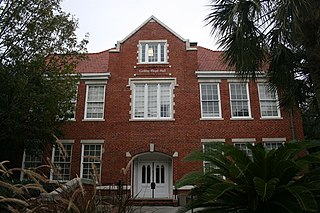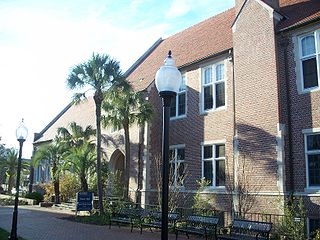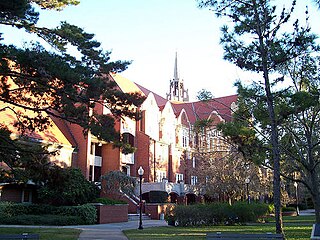
The University of Florida Campus Historic District is a historic district on the campus of the University of Florida in Gainesville, Florida. The district, bounded by West University Avenue, Southwest 13th Street, Stadium Road and Gale Lemerand Drive, encompasses approximately 650 acres (2.6 km2) and contains 11 listed buildings plus contributing properties. On April 20, 1989, it was added to the National Register of Historic Places. On June 24, 2008, additional information was approved which resulted in the addition of 6 contributing properties

Buckman Hall is a historic building located in Murphree Area on the University of Florida campus in Gainesville, Florida, United States. It was designed by architect William A. Edwards in the Collegiate Gothic style and opened in 1906 as one of the two original buildings on the University of Florida's Gainesville campus along with nearby Thomas Hall. It once was a multi-purpose facility but has been used exclusively as a student dormitory since the 1940s.

Griffin–Floyd Hall is a historic academic building located on the northeastern portion of the University of Florida campus in Gainesville, Florida. On June 27, 1979, it was added to the U.S. National Register of Historic Places. It currently houses the Department of Philosophy and Department of Statistics.

Thomas Hall, built in 1905, is a historic building located in Murphree Area on the campus of the University of Florida in Gainesville, Florida, United States. The building is named for William Reuben Thomas, the Gainesville mayor and businessman responsible for bringing the University of Florida to Gainesville.

Kathryn Chicone Ustler Hall is a historic building on the campus of the University of Florida (UF) in Gainesville, Florida. It was designed by William Augustus Edwards in the Collegiate Gothic style and opened in 1919 as the University Gymnasium. In that capacity, the building was the first home of the Florida Gators men's basketball team, and it continued to serve as the home court for most of the university's indoor sports programs until the Florida Gymnasium opened in the late 1940s. The university became co-educational at about the same time, and the building was rechristened the Women's Gymnasium and was repurposed as a recreation center for the school's many new female students. On June 27, 1979, it was added to the U.S. National Register of Historic Places.

Norman Hall is a historic academic building on the eastern campus of the University of Florida in Gainesville, Florida. It was designed by architect Rudolph Weaver in the Collegiate Gothic style, and built in 1932. It originally housed the university's research and development primary and secondary schools, but now is the principal building of the university's College of Education. It is located on U.S. 441, near the southwest corner of S.W. 3rd Avenue and S.W. 12th Street in Gainesville. On January 26, 1990, it was added to the U.S. National Register of Historic Places.
Murphree Area is an historic residence hall complex on the northern edge of the University of Florida campus in Gainesville, Florida. The complex is adjacent to University Avenue, one of the major public roads that serve the university and define its boundaries. It was the university's first residence area and the last one to become co-ed. The Murphree Area complex is named for Albert A. Murphree, the second president of the university, who served from 1909 to 1927. It consists of the following five residence buildings, all built between 1905 and 1939:

The Florida Gymnasium is a historic building located on the campus of the University of Florida (UF) in Gainesville. It opened in 1949 as a 7,000-seat multi-purpose arena and served as the home court of the Florida Gators men's basketball team and other UF indoor sports programs for over thirty years, acquiring the nickname of "Alligator Alley" during that time.

Sledd Hall is an historic student residence building in Murphree Area on the northern edge of the University of Florida campus in Gainesville, Florida. Built in 1929, the dormitory was designed by architect Rudolph Weaver in the Collegiate Gothic style. It is a contributing property in the University of Florida Campus Historic District.

Dauer Hall is a historic building on the campus of the University of Florida in Gainesville, Florida, in the United States.

The Infirmary, now known as the Student Health Care Center, is a historic building on the campus of the University of Florida in Gainesville, Florida in the United States. It was designed by Rudolph Weaver in the Collegiate Gothic style and built in 1931. Since 1983, it has served as a student outpatient clinic.

The Leigh Hall, originally known as the Chemistry-Pharmacy Building, is an historic building on the campus of the University of Florida in Gainesville, Florida, in the United States. It was designed by Rudolph Weaver in the Collegiate Gothic style and was built in 1927. In 1949 the pharmacy college moved to new quarters and the building was renamed Leigh Hall for Townes R. Leigh, longtime chairman of the chemistry department. A west wing was added in 1949 and the building was renovated in 1994.

Murphree Hall is a historic student residence building located in the Murphree Area on the northern edge of the University of Florida campus in Gainesville, Florida. It was designed by architect Rudolph Weaver in the Collegiate Gothic style and completed in 1939. The building was named for Albert A. Murphree, the university's second president, who served from 1909 to 1927. Major renovations, which included adding air conditioning, were completed in 2005, and the hall was rededicated and open for that fall semester.

Walker Hall, originally known as the Mechanical Engineering Building, is an historic classroom building on the campus of the University of Florida in Gainesville, Florida, in the United States. It was designed by Rudolph Weaver in the Collegiate Gothic style and was built in 1927 It was later named for Col. Edgar S. Walker, a civil engineering professor.

The Hub is a historic building on the University of Florida campus in Gainesville, Florida in the United States. It is located on Stadium Road between Buckman Drive and Fletcher Drive.

The Yulee area is a historic residence hall complex at 13th Street and Inner Road, SW, on the University of Florida campus in Gainesville, Florida in the United States. It is the site of the first permanent dormitories built for women after the campus became co-educational in 1947. On June 24, 2008, it was added to the National Register of Historic Places.

The William G. Carleton Auditorium, built in 1954, is a historic building on the campus of the University of Florida in Gainesville, Florida, in the United States. Like several other buildings on campus, it was designed by architect Guy Fulton in an early campus Brutalist style, and it is joined to Walker Hall by a breezeway. It seats 680 and was used as a lecture hall for the University College. In 1970, it was renamed for William G. Carleton, longtime professor of history and social sciences known for the colorful presentation of his freshman "American Institutions" lectures.

The history of the University of Florida is firmly tied to the history of public education in the state of Florida. The University of Florida originated as several distinct institutions that were consolidated to create a single state-supported university by the Buckman Act of 1905. The oldest of these was the East Florida Seminary, one of two seminaries of higher learning established by the Florida Legislature. The East Florida Seminary opened in Ocala 1853, becoming the first state-supported institution of higher learning in the state of Florida. As it is the oldest of the modern University of Florida's predecessor institutions, the school traces its founding date to that year. The East Florida Seminary closed its Ocala campus at the outbreak of the American Civil War and reopened in Gainesville in 1866.


















